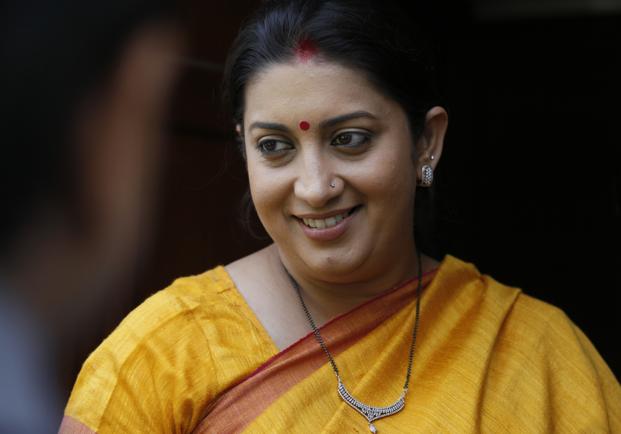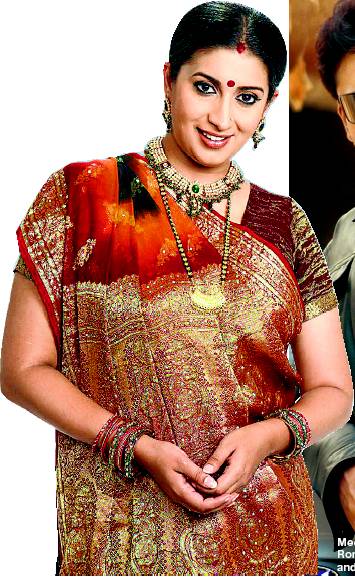
Smriti Irani
Smriti Irani, born on 23rd March, 1976, is a TV actress turned politician. Although the highlights of her career have been her roles on TV and her rise to the office of HRD Minister in 2014 representing the Bharatiya Janata Party, she is also a former model and producer. She is recognized by most Indians by her character Tulsi Virani– a strong and independent yet traditional and value oriented Gujarati bahu (daughter-in-law) in the Indian soap opera Kyuki Saas Bhi Kabhi Bahu Thi. So strong was the influence of her character, that she defined the style and fashion of homemaker / traditional bahus across the country.
Background
Smriti Irani’s popularity with the Indian masses is solely due to her stellar performance as Tulsi between 2000 and 2007. Indian audiences, especially women, were so taken with the character that her trademark Gujarati style draping of her saree, the simplicity of the big red bindi (a decorative mark worn in the middle of the forehead by Indian women, especially Hindus), her mangalsutra (is a sacred necklace in the Hindu tradition that a groom ties around the bride’s neck on the day of their wedding) and gorgeous chunky neck pieces that complement her saree along with jhumkis (dangling earrings) to match, became a style mantra to swear by. This trademark style made her one of the most identifiable fashion icons in the 2000s. Echoes of this style remained throughout the series, even as the clothes and accessories went through the customary evolutionary stages as the character matured. An undeniable era in Indian pop-culture, Smriti Irani’s trademark Tulsi–style offered her a lot of leverage during her political campaigns as well.
Sources of Inspiration
Her look during the run of the series was inspired by the storyline and character conceptualization- a Gujarati woman who marries into an affluent household and is the epitome of ‘The Ideal Homemaker’. Although her overall style remains consistent throughout the series, her look is inspired a lot by the events of the soap, the evolution of the character and the dynamics of the fictional family, to which she is the anchor. Overall, Smriti Irani’s quintessential look has been modest yet a reflection of a typical well-to-do Gujarati family.
Style and Variety
While her sarees in themselves are in a variety of different materials, i.e. chiffon, georgette, crepe, cotton, silk and faux in all its variety, the drape of the saree was always Gujarati, that can be identified by the pallu being draped across the chest and covering the mid-riff.
Depending on the theme of the episode, Smriti as Tulsi Virani also sported a variety of embroidery and other work on her sarees and pallu. Right from heavy faux zari work, to sequins and embroidery, to leheriya prints, the audiences connected immediately with Smriti Irani’s character’s look. The colours of her saree have always been vibrant and energetic, reflecting the culture of a run-of-the-mill Gujarati family, unless the storyline demanded otherwise. The blouses she sported throughout the series can mostly be classified as the regular U-neck or a high-collar in the later stages of the character’s life.
Concerning accessories, a trademark Smriti Irani as Tulsi move, is to wear the mangalsutra and sindoor (red, powdered pigment applied in the parting of the hair of married Hindu women) along with a noteworthy pair of earrings or studs that complement the look of the saree. However, on special occasions, the character has also been seen wearing heavy neck-pieces in gold with embellishments of other semi-precious stones.
A subtle yet integral part of Smriti Irani’s character’s overall look has been the bangles on her hands. Although, the number and type of the bangles she wears, varies throughout the series, it is a vital accessory to the character that defines her glamour as a modern yet traditional bahu.
Influence of the Look
As Tulsi Virani, Smriti Irani gained immense popularity amongst the regular Indian households as a strong feminist who women around the country could relate to. As opposed to defining feminism as modernity translated in fashion as shorter or hotter clothes, Smriti Irani influenced thousands of women across the country to embrace their roles within their homes and take a stronger stand for what they believed in, in a saree draped Gujarati-style. The style of Irani as Tulsi became a representation of such feminism in India, symbolizing Indian values in the modern woman who believes equally in sustaining the Indian customs and traditions. Everything from the clothes in all their glorious styling to the bun and the accessories became a part of the middle-class Indian woman’s daily wardrobe.
While this next facet of her influence cannot be classified as grand-scale, it was observed that her character made wearing a front-pallu stylish. For women who do not wish to expose their mid-riffs, this became more than just a save from patriarchal ridicule. Irani’s character’s style made it acceptable for women to cover their front portions and still be considered stylish.
Personal Style
Off the ramp and the small screen, Smriti Irani has been spotted wearing sarees as well as Indian salwar-kameez or a churidaar in luscious, rich colours. Before entering politics she was often spotted wearing casual western outfits on a day out in the city. However, since her entry into the Indian political scene, her campaigning in Amethi and her rise to the position of HRD Minister she has been seen wearing cotton sarees in earthy and warm colours. The media reported that during the General Elections’ rallies in 2014, she wore sarees in hues of orange to each of them in keeping with her association to BJP’s saffron. Occasionally one does see her wearing more vibrant sarees. Besides the cotton saree, the red bindi and sindoor are essential parts of her personal style.
Facts and Trivia
- Smriti Irani worked as a waitress in McDonald’s (Mumbai) to support her family, which includes two younger sisters.
- Along with one of her co-stars from Kyuki Saas Bhi Kabhi Bahu Thi, Irani was one of the finalists on India’s most prestigious talent competitions, Miss India in 1998.
- Although the youngest person on Narendra Modi’s cabinet, Smriti Irani is the incumbent for one of the most high profile ministries in the Indian polity, Ministry of Human Resource Development.
- Irani is fluent in many languages, including Marathi, Bengali and Gujarati.
Reference Links
Categories: Bollywood & Beyond, The TV Show

